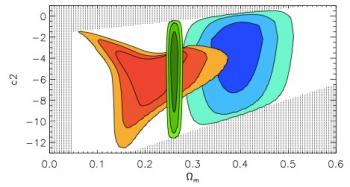Publications majeures de SNLS :
Publications du groupe du DPhP :

Contraintes sur deux des paramètres d’un modèle Galiléon réduit à sa solution dite ‘tracker’. Les contraintes des supernovae Ia (bleu), du rayonnement fossile combiné aux oscillations de baryons (vert) et du taux de croissance des structures (orange) sont en fort désaccord. Cette solution est donc rejetée. Par contre, le modèle du Galiléon général est en aussi bon accord avec ces mêmes données que le modèle de la constante cosmologique. Tiré de Neveu et al., arXiv:1605.02627.
Thèses effectuées dans le groupe du DPhP :
V. Lusset (2003-2006), G. Bazin (2005-2008), J. Neveu (2011-2014), A. Möller (2012-2015).
